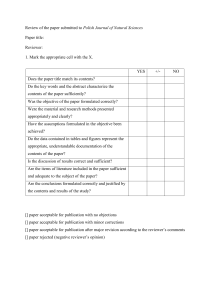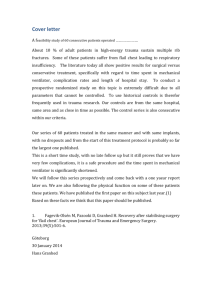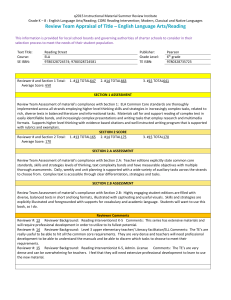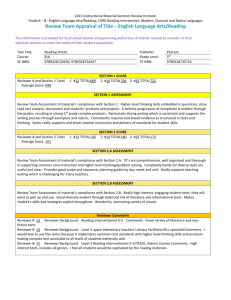The Reviewer Process: Questions and Answers
advertisement
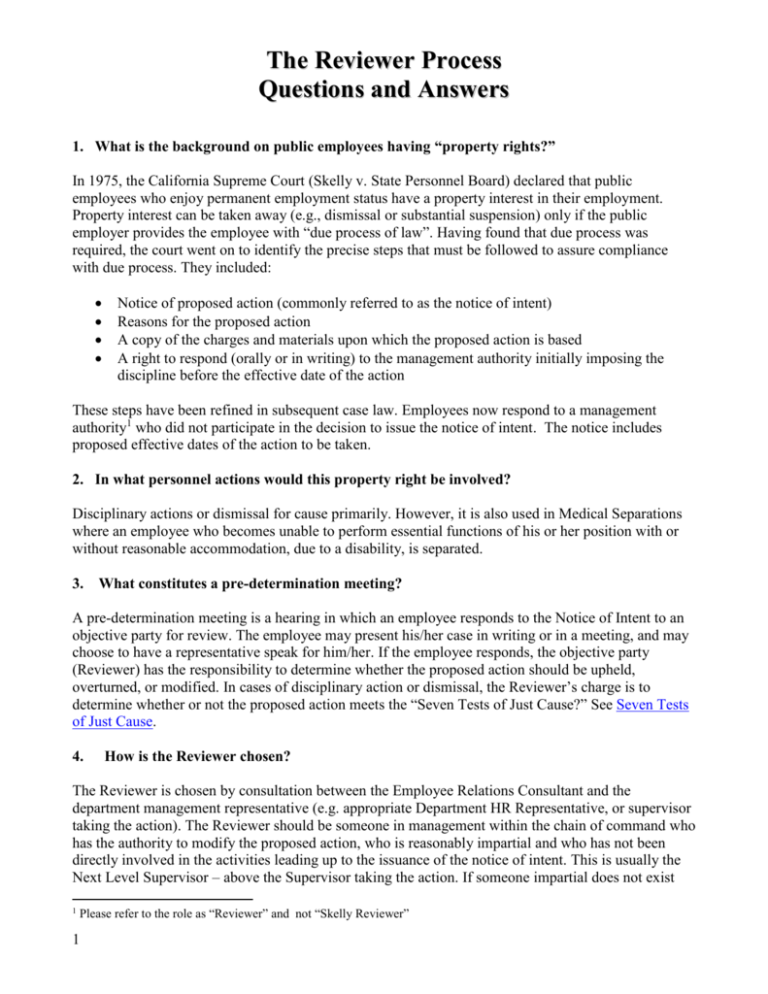
The Reviewer Process Questions and Answers 1. What is the background on public employees having “property rights?” In 1975, the California Supreme Court (Skelly v. State Personnel Board) declared that public employees who enjoy permanent employment status have a property interest in their employment. Property interest can be taken away (e.g., dismissal or substantial suspension) only if the public employer provides the employee with “due process of law”. Having found that due process was required, the court went on to identify the precise steps that must be followed to assure compliance with due process. They included: Notice of proposed action (commonly referred to as the notice of intent) Reasons for the proposed action A copy of the charges and materials upon which the proposed action is based A right to respond (orally or in writing) to the management authority initially imposing the discipline before the effective date of the action These steps have been refined in subsequent case law. Employees now respond to a management authority1 who did not participate in the decision to issue the notice of intent. The notice includes proposed effective dates of the action to be taken. 2. In what personnel actions would this property right be involved? Disciplinary actions or dismissal for cause primarily. However, it is also used in Medical Separations where an employee who becomes unable to perform essential functions of his or her position with or without reasonable accommodation, due to a disability, is separated. 3. What constitutes a pre-determination meeting? A pre-determination meeting is a hearing in which an employee responds to the Notice of Intent to an objective party for review. The employee may present his/her case in writing or in a meeting, and may choose to have a representative speak for him/her. If the employee responds, the objective party (Reviewer) has the responsibility to determine whether the proposed action should be upheld, overturned, or modified. In cases of disciplinary action or dismissal, the Reviewer’s charge is to determine whether or not the proposed action meets the “Seven Tests of Just Cause?” See Seven Tests of Just Cause. 4. How is the Reviewer chosen? The Reviewer is chosen by consultation between the Employee Relations Consultant and the department management representative (e.g. appropriate Department HR Representative, or supervisor taking the action). The Reviewer should be someone in management within the chain of command who has the authority to modify the proposed action, who is reasonably impartial and who has not been directly involved in the activities leading up to the issuance of the notice of intent. This is usually the Next Level Supervisor – above the Supervisor taking the action. If someone impartial does not exist 1 Please refer to the role as “Reviewer” and not “Skelly Reviewer” 1 The Reviewer Process Questions and Answers within the chain of command, a Reviewer may be chosen from management in another unit or department. (See Letter of Reviewer Designation (from Next Level Supervisor) (Word) 5. What are the roles of the Reviewer, the Employee Relations Consultant and the Supervisor? The Reviewer’s role is not to initiate a whole new investigation, but to hear from the employee and/or the employee’s representative why the proposed action is not warranted. S/he must review any relevant material presented by management in the intent letter and in the employee’s response. If appropriate, s/he must interview other involved parties, such as witnesses, to obtain corroboration of information provided in the Notice of Intent or in the employee’s response. It is the Reviewer’s responsibility to make a final decision and communicate this decision directly to the individual who issued the intent letter (usually the Supervisor), who will then deliver it to the employee in a final notice. If the employee responds during the appeal period, the Reviewer may uphold the intended action, or reduce the action. In disciplinary cases only (not Medical Separation), the Reviewer must determine if the supervisor met the “Seven Tests of Just Cause” in taking the intended action. NOTE: Once the employee contacts the Reviewer during the notice period, the Reviewer should immediately tell the employee that the intended action is on hold, and advise the department. The department should promptly send the employee a Letter2 that the intended action is on hold, and the date of the proposed action is extended. The department may need to send additional extensions, depending upon the length of the review. If the employee does not respond during the appeal period, the Reviewer notifies the supervisor that the intended action was not challenged by the employee and upholds the intended action. The Employee Relations Consultant3 serves as an advisor to the Reviewer. They may confer prior to the review meeting to discuss roles and the process of that meeting, or to discuss an employee’s written response. The Employee Relations Consultant advises about relevant personnel policies, contract provisions, practices and procedures, possible outcomes, financial impact, and settlements. The Supervisor, in most cases, has no active role after the intended action has been issued in writing, except to issue the final written decision to the employee. (Note-- The supervisor should not advise or “influence” the Reviewer in any way.) 2 See Reviewer Resources at the end of this document. The Employee Relations Consultant, who advises the department, is not the same Employee Relations Consultant who serves as an advisor to the Reviewer. This arrangement will be coordinated by the Employee Relations Consultant who advises the department. 3 2 The Reviewer Process Questions and Answers 6. Who attends a Review meeting? Those in attendance may be: The employee and his/her representative (if employee is bringing a representative)4 The Employee Relations Consultant advising the Reviewer The Reviewer 7. What is the Reviewer’s time frame for making a decision? There is no established time limit. (There is the effective date of the action which nears and may need to be extended - see below.) However, the employee in most cases, is on pay status and is uncertain about a final outcome. The Reviewer needs to be conscious of the possible financial impact delays might cause, as well as unnecessary anxiety for the employee. The Reviewer has the authority to extend the response deadline if s/he deems it necessary. Depending upon the policy or contract provision under which the notice of intent was sent, it may be necessary to document any extension or time taken beyond the number of days specified in that provision. 8. What should the final notice from the Supervisor include? The final action to be taken, the effective date of the action and reasons for the action based on the Reviewer’s decision For disciplinary actions short of dismissal, expectations of performance/behaviors the employee is to make improvements in the future (if applicable) A copy of the Reviewer’s decision (or notice from Reviewer that the employee did not respond) A copy of the Notice of Intent Letter (with attachments) Appeal rights under policy or contract Proof of service Copies to the employee’s representative, the Employee Relations Consultant, the supervisor, the departmental personnel file, and other offices/individuals as appropriate. Reviewer Resources 4 Seven Tests of Just Cause Disciplinary Alternatives Disciplinary Letters Letter of Reviewer Designation (from Next Level Supervisor) (Word) Outside of the scheduled meeting, the Reviewer should not communicate with the Representative. For example, if the Reviewer is contacted by the Representative prior to the meeting, the Reviewer should refer the Representative to the Employee Relations Consultant. 3 The Reviewer Process Questions and Answers 4 Sample Reviewer Response Letter (if Employee Has Responded) (Word) Sample Reviewer Response Letter (if Employee Has Not Responded) (Word) Letter of Intended Action on Hold (Word)



